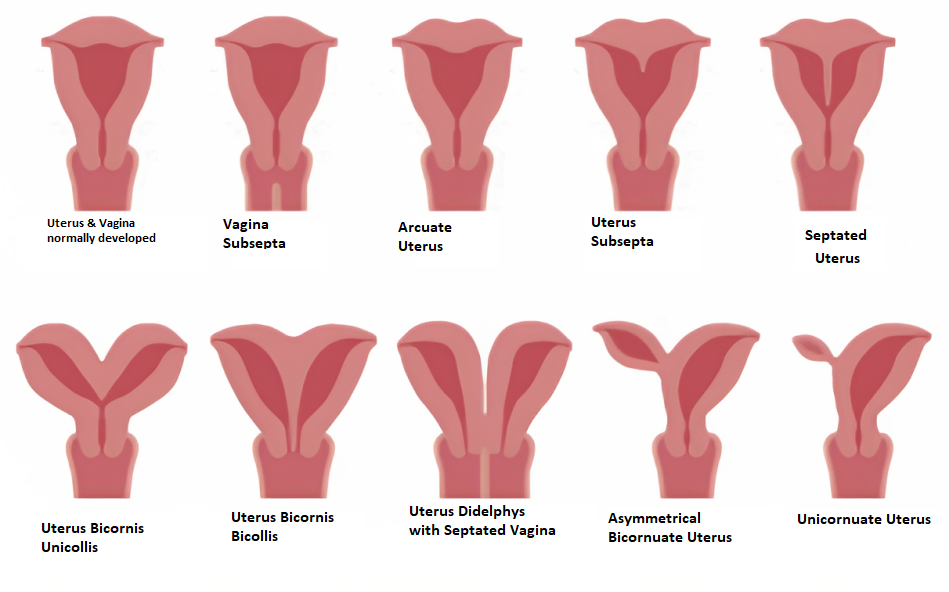Uterus didelphys is a rare congenital abnormality in which a person is born with two uteruses. It’s also known as a double uterus. The failure of the two Müllerian ducts to merge properly during embryonic development results in a double uterus.
A person with complete uterus didelphys has two independent uterine cavities, two cervices, and a double vagina. The vaginal septum may range from thin and easily displaced to thick and inelastic. The illness is extremely rare, affecting only 0.3% of the population.
Table of Contents
Uterine Malformattion Classification

Uterine malformations according to the American Fertility Society:
- Class I: Uterine agenesis/hypoplasia – This refers to a complete or partial absence of the uterus or a severely underdeveloped uterus.
- Class II: Unicornuate uterus – This refers to a uterus that develops from one of the two Müllerian ducts, resulting in a small uterus with one fallopian tube.
- Class III: Didelphic uterus – This refers to a complete duplication of the uterus, cervix, and vagina resulting in two separate uteri and cervices.
- Class IV: Bicornuate uterus – This refers to a uterus that has two distinct horns that extend from a single cervix.
- Class V: Septate uterus – This refers to a uterus that has a septum, or wall of tissue, dividing the uterus into two separate cavities.
- Class VI: Arcuate uterus – This refers to a uterus with a slight indentation at the top of the uterus, but is generally considered a normal variation and not a true malformation.
Symptoms of Complete Uterus Didelphys
Most persons with complete uterine didelphys have no symptoms and may be unaware of their illness until they receive a pelvic exam or an imaging test for another reason. However, the following symptoms are possible:
- Pain during sex
- Painful cramping before and during periods
- Heavy bleeding during periods
- Leaking blood when using a tampon (because it only covers one vagina)
- Frequent miscarriages
- Preterm labor
Causes of Complete Uterus Didelphys
It is unknown what causes complete uterine didelphys. It is a congenital anomaly caused by the failure of the two Müllerian ducts to merge properly during embryonic development. The Müllerian ducts give rise to the female reproductive organs like the uterus, fallopian tubes, cervix, and vagina. These tubes normally connect to form a single uterus with one cervix and one vagina. The ducts stay separate in complete uterus didelphys, resulting in two uteruses, two cervices, and two vaginas.
Complete uterine didelphys may be associated with additional renal system problems (such as having only one kidney) and skeletal system disorders (such as scoliosis).
Diagnosis
Complete uterus didelphys can be diagnosed by a pelvic exam, where the doctor may feel two cervices and two vaginas. Other tests that can be used to confirm the diagnosis include:
Transvaginal ultrasound: This technique creates images of the pelvic organs using sound waves. It can reveal the shape and size of the uteri and cervix.
Sonohysterography: It entails injecting fluid into the uterine cavity followed by an ultrasound. It can display the uterine cavity outline and detect any anomalies.
Hysterosalpingography: This procedure involves injecting dye into the uterus and fallopian tubes, followed by X-rays. It can provide information on the shape and patency of the uterine cavity and fallopian tubes.
MRI: A magnetic field is used to obtain detailed images of the pelvic organs. It is capable of displaying the anatomy of the uterus, cervix, vagina, ovaries, and fallopian tubes.
Hysteroscopy: This involves inserting a thin camera through the cervix into the uterus. It can show the inside of the uterine cavity and detect any abnormalities.
Treatment
Unless there are symptoms or consequences, most cases with complete uterus didelphys do not require treatment. Some therapy options include:
Pain relievers: These can aid with pain relief during sex or menstruation.
Hormonal contraception: This can help control menstrual cycles and minimize bleeding.
Surgery: This may be required to remove or resect the vaginal septum in order to create a single vagina. This can help with sexual function and pain relief. However, surgery may not be advised if there is a risk of harming the vaginal blood supply or nerves.
Fertility treatment: This may be beneficial for patients with complete uterus didelphys who are having trouble conceiving or carrying a pregnancy to term. This could include treatments like intrauterine insemination (IUI) or in vitro fertilization (IVF).
Pregnancy with Complete Uterus Didelphys
People with complete uterus didelphys can get pregnant and have healthy babies, but they may face some challenges and risks. Some possible issues are:
Ovulation: People with complete uterus didelphys may ovulate from both ovaries in the same cycle or alternate between the ovaries in different cycles. This can affect the timing and frequency of ovulation and make it harder to predict fertile days.
Implantation: People with complete uterus didelphys may have a reduced uterine cavity size and blood flow, which can affect the implantation and growth of the embryo. The embryo may implant in either uterus or in both uteruses (in the case of twins).
Miscarriage: People with complete uterus didelphys have a higher risk of miscarriage, especially in the first trimester. This may be due to abnormal uterine contractions, hormonal imbalance, or chromosomal abnormalities in the embryo.
Preterm labor: People with complete uterus didelphys have a higher risk of preterm labor, which is labor that occurs before 37 weeks of pregnancy. This may be due to uterine overdistension, cervical incompetence, infection, or placental abruption.
Breech presentation: People with complete uterus didelphys have a higher chance of having a baby in a breech position, which is when the baby’s feet or buttocks are facing down instead of the head. This may be due to the shape and size of the uterine cavity or the presence of a vaginal septum.
Cesarean delivery: People with complete uterus didelphys have a higher rate of cesarean delivery, which is when the baby is delivered through a surgical incision in the abdomen. This may be due to breech presentation, fetal distress, placenta previa, or previous cesarean delivery.
Tips for Pregnancy with Complete Uterus Didelphys
If you have complete uterine didelphys and are considering or are already pregnant, here are some pregnancy recommendations to help you have a good and safe pregnancy:
Consult your doctor: Your doctor can assist you in determining your reproductive status, monitoring your ovulation, and providing prenatal care. Your doctor can also advise you on the best way to birth your baby.
Take prenatal vitamins: Prenatal vitamins can help you achieve your nutritional demands while also preventing birth abnormalities in your baby. Your doctor may advise you to take folic acid, iron, calcium, and vitamin D supplements.
Consume a well-balanced diet: A well-balanced diet can help you maintain a healthy weight while also providing critical nutrients for your baby’s development. Eat a variety of fruits and vegetables, complete grains, lean protein, and healthy fats. You should also abstain from alcohol, caffeine, cigarettes, and illegal drugs.
Drink plenty of water: Drinking plenty of water can help you avoid dehydration, constipation, urinary tract infections, and preterm labor. If you exercise or live in a hot climate, you should drink at least eight glasses of water every day.
Exercise Moderately: Moderate physical activity can help you enhance your mood, blood circulation, muscle strength, and endurance. It can also assist you to avoid gaining too much weight, gestational diabetes, preeclampsia, and back pain. At least 30 minutes of moderate activity every day, such as walking, swimming, yoga, or cycling, is recommended. Avoid high-impact activities such as twisting, jumping, or laying on your back.
Get enough rest: Getting enough rest might help you deal with exhaustion, stress, and mood swings. It can also assist you in preparing for labor and delivery. You should get at least eight hours of sleep per night and, if necessary, nap throughout the day. Avoid sleeping on your back and use pillows to support your stomach and legs.
Seek assistance: It can be difficult and frustrating to get complete uterine didelphys. You may experience anxiety, depression, isolation, or guilt. Others may also stigmatize, discriminate against, or misunderstand you. Seek help from your partner, family, friends, doctor, therapist, or a support group. You are not alone, and you have earned the right to be happy and healthy.
Conclusion
Complete uterine didelphys is an uncommon congenital abnormality characterized by the presence of two uteruses, two cervices, and a double vagina. It can cause some pregnancy symptoms and difficulties, including discomfort, bleeding, miscarriage, premature labor, breech presentation, and cesarean delivery. People with complete uterine didelphys can, however, have healthy and successful pregnancies and births with sufficient care and support. They can also enjoy their sexuality and fertility without feeling embarrassed or afraid. Complete uterine didelphys are a blessing that makes them distinct and remarkable.
FAQs
Q: What is complete uterus didelphys?
A: Complete uterus didelphys is a rare congenital condition where a person has two uteruses, two cervices, and a double vagina.
Q: What causes complete uterus didelphys?
A: Complete uterus didelphys is caused by the failure of the two Müllerian ducts to fuse properly during embryonic development.
Q: How common is complete uterus didelphys?
A: Complete uterus didelphys is very rare and affects only about 0.3% of the population.
Q: How is complete uterus didelphys diagnosed?
A: Complete uterus didelphys can be diagnosed by a pelvic exam, ultrasound, sonohysterography, hysterosalpingography, MRI, or hysteroscopy.
Q: How does complete uterus didelphys affect pregnancy?
A: Complete uterus didelphys can affect pregnancy by causing pain, bleeding, miscarriage, preterm labor, breech presentation, and cesarean delivery.
Q: How can I have a healthy pregnancy with complete uterus didelphys?
A: You can have a healthy pregnancy with complete uterus didelphys by consulting your doctor, taking prenatal vitamins, eating a balanced diet, staying hydrated, exercising moderately, getting enough rest, seeking support, and celebrating your uniqueness.
Latest Posts
- Top Gynecology Questions and Answers for Nursing Exams | Detailed Rationales 2024

- AIIMS NORCET, RRB, and NVS Nursing Exam: Top Questions and Answers for Success 2024



- Urgent: Railway Nurse Recruitment 2024 – How to Apply Railway Nurse



- NVS Staff Nurse Vacancy 2024 – How to Apply



- AIIMS NORCET 6 and ESIC Nursing Exam Questions and Answers



